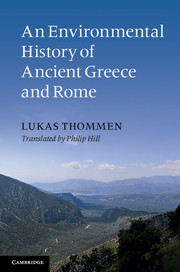Book contents
- Frontmatter
- Contents
- Figures
- Preface
- Introduction
- Part I Greece
- Chapter 1 The geographic space
- Chapter 2 People and nature
- Chapter 3 Agriculture
- Chapter 4 Forests and timber
- Chapter 5 Gardens
- Chapter 6 Animals
- Chapter 7 Food
- Chapter 8 Fire and water
- Chapter 9 Earthquakes and volcanoes
- Chapter 10 Mining
- Part II Rome
- Chronology
- Further reading
- Sources
- Bibliography
- Index
Chapter 5 - Gardens
Published online by Cambridge University Press: 05 June 2012
- Frontmatter
- Contents
- Figures
- Preface
- Introduction
- Part I Greece
- Chapter 1 The geographic space
- Chapter 2 People and nature
- Chapter 3 Agriculture
- Chapter 4 Forests and timber
- Chapter 5 Gardens
- Chapter 6 Animals
- Chapter 7 Food
- Chapter 8 Fire and water
- Chapter 9 Earthquakes and volcanoes
- Chapter 10 Mining
- Part II Rome
- Chronology
- Further reading
- Sources
- Bibliography
- Index
Summary
In the Near East and Egypt the most important gardens were located in the surroundings of the ruling dynasties, with the palace and the sacred site forming a unit. The so-called Hanging Gardens of Babylon of Semiramis, an Assyrian queen who lived around 800 bc, were later included among the Seven Wonders of the Ancient World. These gardens have not been identified, but probably formed a terrace structure over dome-shaped substructures, such as those built under Nebuchadnezzar II during the first half of the sixth century bc. Moreover, Near Eastern rulers kept artificial animal-parks surrounded by walls, the so-called paradeisoi. They served for the royal hunts, which made the king, together with the god, the lord over nature, and which also recalled the Garden of Eden. Hellenistic rulers and Roman aristocrats would later be happy to continue with this tradition.
In the city states (poleis) which developed in Greece during the early part of the first millennium bc, the municipal centres left space for religious ceremonies and public meetings, but the residential areas had very little green space. Sacred gardens or public sacred groves were mainly located outside the actual housing areas. According to traditional belief, sacred beings dwelt in such places – be they gods, nymphs or heroes. A sacred grove (alsos) was generally a place in open natural surroundings with a cluster of trees, a brook, a field or a grotto. It was marked by a ritual figure and mostly enclosed by a wall, so that the designated plot was called a temenos. However, unlike the Near Eastern royal gardens, it remained accessible to all. Its fundamental features were its communal religious aspect and its untamed natural character, located at the transition to civilisation. Sacred groves were thus protected against uncontrolled intervention (Thuc. 3.70.4; Callim. hymn. 6.24–60). In Athens the sacred olive trees dedicated to Athena were generally protected from being felled or dug up (Lys. 7).
- Type
- Chapter
- Information
- An Environmental History of Ancient Greece and Rome , pp. 42 - 44Publisher: Cambridge University PressPrint publication year: 2012



